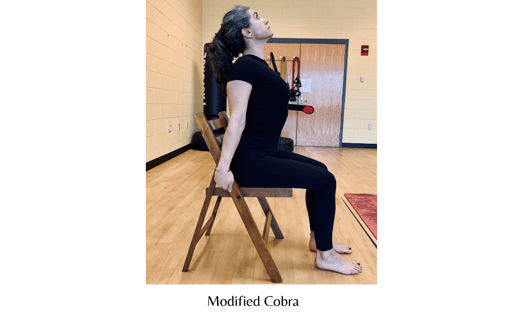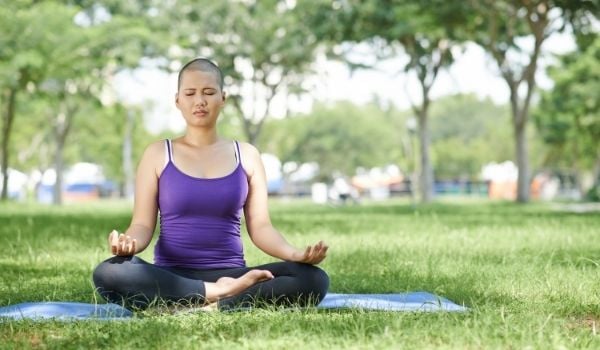
By: Jennifer Cashwell, MSN, FNP-BC
With the increasing success of cancer treatments and the ability to return to previous family, social, and work activities, symptom management and quality of life are essential for cancer survivorship. Mindfulness, meditation, and yoga have consistently shown benefits to cancer patients and survivors. They can decrease unpleasant side effects of cancer treatment, such as nausea and vomiting, reduce stress, increase a feeling of calm, improve mood and sleep quality, and increase mental acuity.
A cancer diagnosis can generate many emotions, including fear about one’s own health; worry about how family will cope and be cared for; anxiety surrounding the onslaught of blood work, imaging tests, surgeries, and treatments, to name a few. Patients can feel an utter lack of control over their own bodies, physically and mentally. Cognitive function can be affected by chemotherapy, reduced hormone levels, and stress. Mindfulness, meditation, and yoga can help cancer patients and survivors regain control over their bodies and lives.
Practicing Mindfulness
Mindfulness is the act of paying attention to the things you are experiencing and choosing peacefulness in relation to every action, person, thought, feeling, and response.
Practicing mindfulness will help you be fully present to what is happening in the moment. It will help train your attention so that you do not ruminate over the past or race into the future. It reinforces feelings of openness, acceptance, and compassion and decreases our natural tendency to judge. Additionally, mindfulness may reduce age-related cognitive decline.
Ways to practice mindfulness:
- Mindful breathing: Follow your breath as you inhale and exhale. This basic mindfulness practice calms the emotions and settles the body. Pay attention to the sensations in your body as you breathe—air coming in the nose, the abdomen expanding, etc. When your mind wanders, acknowledge the thought, then return to the breath.
- Mindful listening: Close your eyes. Pick out the furthest sound you can hear (for example, traffic noise); acknowledge it, then move on. Continue in the same manner, working inward from far away sounds to sounds closer to you, listening and acknowledging each one. Finish by focusing on sounds made by your own body (for example, breathing and the movement of your hair).
- Mindful walking: Feel the sand below your toes. Feel the sun on your skin. Smell the salt in the ocean and hear the waves crashing. Hear the crunching of leaves beneath your feet. When your mind wanders, acknowledge the thought, then return to the sounds, the touch, and the smells.
- Mindful eating: Focus on the smell and taste of your food, the feel of the fork in your mouth, and the feeling of fullness in your stomach.
Remember, the point of mindfulness is to fully experience and appreciate what you are encountering in the present moment. Distracting thoughts may come up, worries may enter your mind; acknowledge them, then bring yourself back to the present. You can practice mindfulness anytime.
Benefits of Meditation for Cancer Patients
Meditation, by contrast, asks that you set aside time to relax your mind and body and focus.
There are many ways to meditate. You can practice anywhere, and you don’t need any special equipment. You should choose a special place for sitting where you are comfortable but still alert, for example, on the sofa or upright in bed. Set a timer; you can start with just 5 minutes. This will allow you to relax and not be focused on counting time. Begin by focusing on the breath and feeling the physical sensations of breathing.
Transcendental meditation has been shown to reduce depression and anxiety, treat insomnia, decrease PTSD, and promote a sense of calm. Studies suggest meditation can even lower blood pressure and the risk of heart disease. Below are a few tips if you are beginning to practice meditation.
- Sit in a relaxed position.
- Close your eyes.
- Breathe normally. Don’t think about your breathing.
- Chant the mantra inside of you. This could be a word, a phrase, or something you are trying to emulate or incorporate. Some examples include “Strength,” or “I am strong,” or ”In, out,” or “Peace in, calm out.”
- If your mind wanders, bring back the attention to the mantra. Allow other thoughts to float by.
- You may experience moments of “transcendence,” a pleasant feeling of restful alertness.
- After 20 minutes, open your eyes slowly and gently.
Benefits of Yoga for Cancer Patients
Yoga has been found to decrease anxiety and stress, help cancer patients perform daily and routine activities, and improve quality of life in cancer patients. Yoga reduces depression, pain, and fatigue. Being able to move your body can empower you to feel in control of your body.
Some cancer treatments can cause joint stiffness and aches. Others can worsen osteopenia/osteoporosis. Yoga can help decrease these symptoms, and weight-bearing exercises such as yoga can strengthen bones.
Yoga Poses for Strength and Flexibility
Here are some simple yoga poses that help with strength and flexibility. Examples include the usual pose and the less strenuous, modified pose. As always, check with your VOA provider or PCP before beginning a new exercise program to be sure it is suitable.
Thank you to yoga instructors Bridget Waddell, RYT-200, and Daniela Bowen, ERYT-200 for their contributions.
1. Cat & Cow
Usual pose. Cow: Get on all fours. Inhale, release the belly, curving the spine and lifting your chin. Cat: Exhale, and arch your back, drawing your belly button close to your spine and your chin to your chest. Repeat 5 times.

Modified pose. Seated Cat & Cow: Same poses may be performed while seated in a chair. Inhale and lift/expand your chest, arching the back. Exhale and round your back, tucking your chin forward.
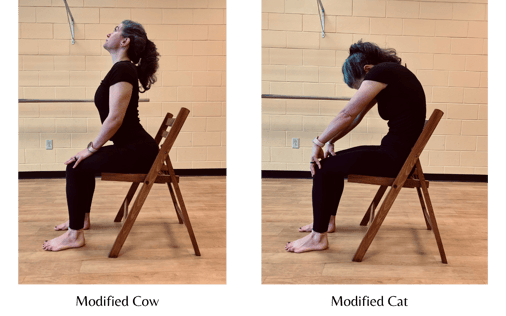
2. Crescent Arm
This can be done in several ways to suit the body—standing, seated, or on a chair. Elongate the spine. Arch over to the right, expand and breathe through the left ribcage. Then straighten up and arch over to the left, expand and breathe through the left ribcage.
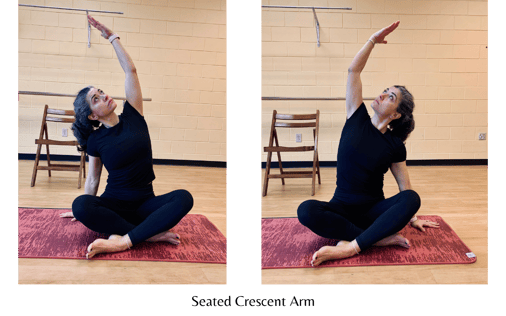
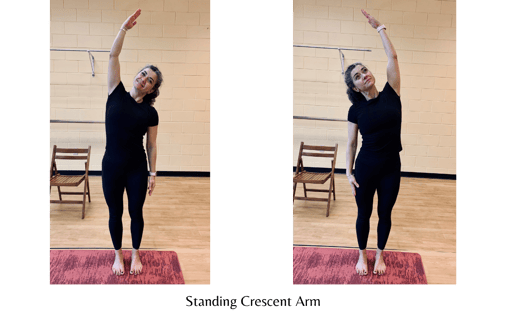
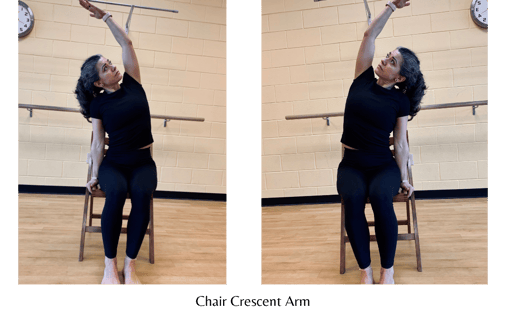
3. Child’s Pose
Usual Pose. Down on the floor, feet together, knees wide, arms extended. Breathe. Walk hands over to the right and then through the center and to the left.
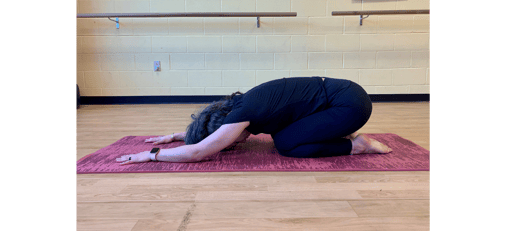
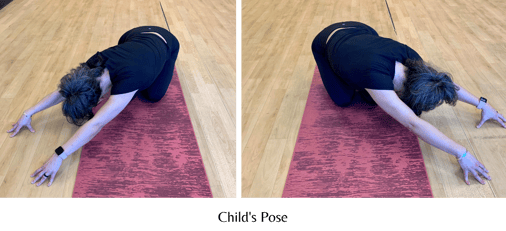
Modified pose. Seated forward fold: Sit tall with a neutral spine. Exhale and fold gently forward over your thighs, reaching hands toward the floor. Hand to the floor as needed for support.
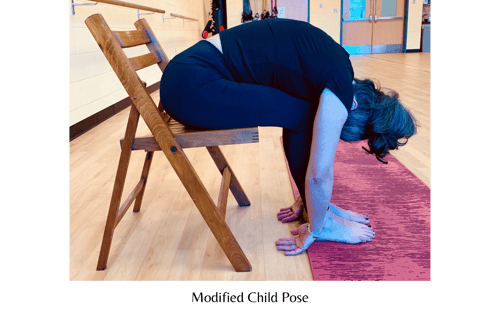
4. Goddess
Usual Pose. Stand with legs wide, toes facing outward, goddess arms at 90 degrees. Inhale; on the exhale, squat down 4-6 inches. Inhale, lift arms up overhead and wide. Repeat 4-6 times.
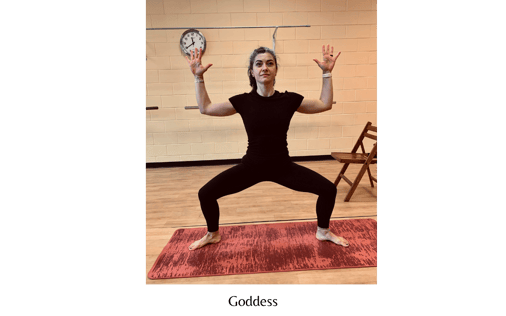
Modified pose. The same wide leg pose can be performed holding onto a chair or seated.
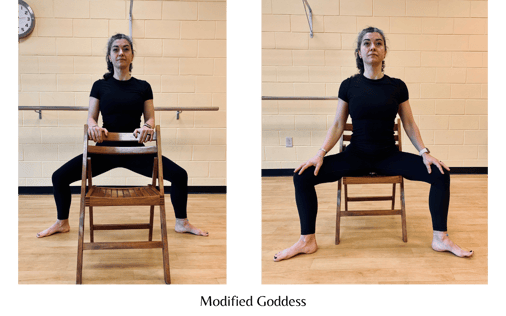
5. Warrior 2 — To Open the Hips
Usual Pose. Stand with one foot’s toes pointed forward. Step back with the other foot and turn toes out 90 degrees. Deep bend in the front knee, arms extended out in a long line parallel to the floor. Hips should be pointed in the same direction as the back foot. Repeat on the other side.
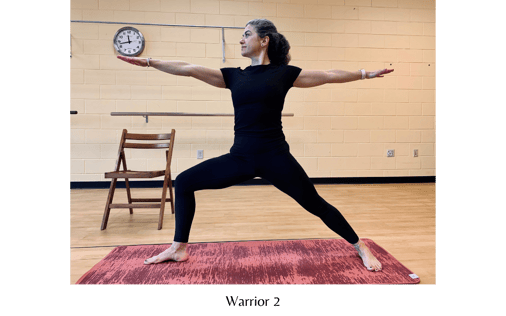
Modified pose. The same pose can be performed while holding onto a chair.
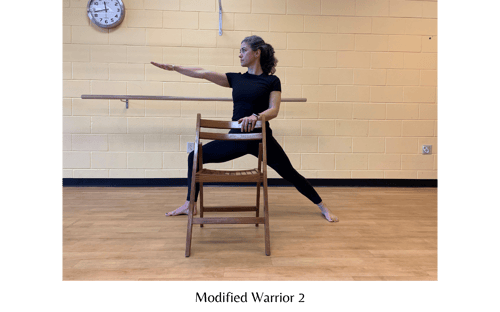
You can get the same stretch by sitting the thigh and buttock of the front leg onto a chair.
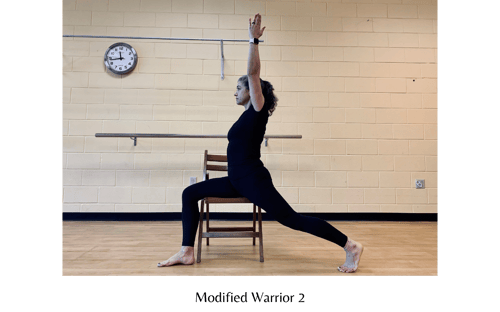
6. Tree Pose — For Balance and Cognitive Function
Usual Pose. Stand on both feet. Bring the right foot onto the ankle, calf, or upper thigh (not on the knee joint). Ground through the standing foot. Arms at prayer or extended overhead. Repeat with the opposite leg.
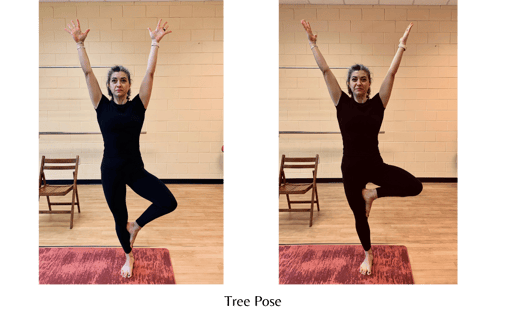
Modified pose. You may put your weight into one foot and rest the opposite toes on the ground. You may also perform a tree pose while holding onto a chair.

7. Cobra
Usual Pose. Lie on your stomach, hands under the shoulders. Press gently into your hands and arch your back. Do not overextend or collapse your neck.
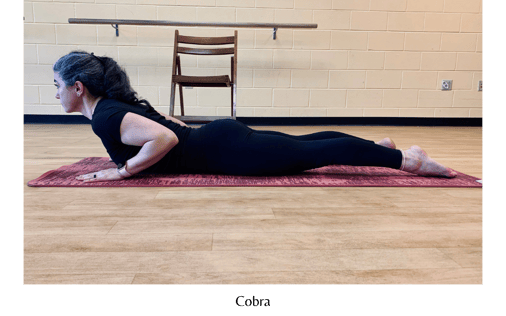
Modified pose. Sit on a chair. Press hands into the seat beside your hips, or grab onto the sides of the chair. Arch your back and extend the neck. Be sure not to overextend or collapse your neck.
